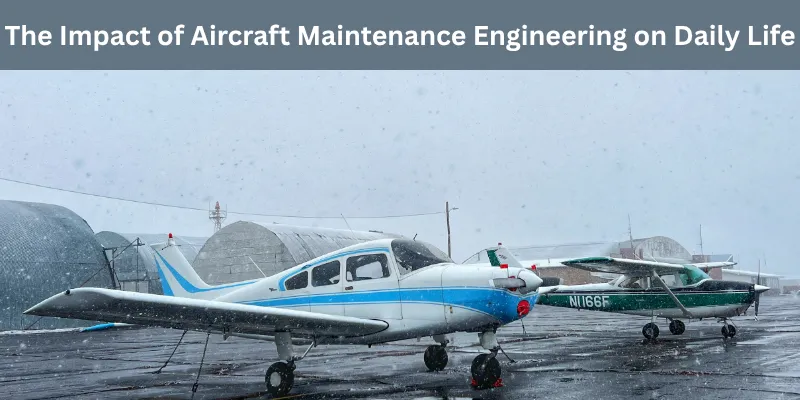

You rush to catch a flight for your best friend's wedding. The plane takes off on time—no delays, no worries. But have you ever wondered who makes that possible? Behind every smooth flight is an aircraft maintenance engineer, quietly working to keep planes safe, reliable, and ready for everyday journeys.
When people think about aircraft, they usually imagine busy airports or vacation trips. But aircraft maintenance engineering reaches far beyond that. It affects your everyday life—even if you’re not flying.
Your Amazon Package Flew in Too
Ordered something online recently—like a phone case, gift, or groceries? It likely flew on a cargo plane. These planes operate daily worldwide and must stay flight-ready. That’s where aircraft maintenance engineers step in.
Their work keeps planes safe and on time, ensuring fast, reliable delivery—even for critical items like medicine.
Affordable Flights, Thanks to Efficient Maintenance
Wondering how plane maintenance affects your wallet? Simple—well-maintained aircraft break down less, reducing delays, costly fixes, and airline expenses. Lower costs mean airlines can offer more affordable flights, better deals, and more options for you.
When we think of flying, we picture pilots, cabin crew, or planes in the sky. But every safe flight depends on aircraft maintenance engineers—the hidden heroes working around the clock to keep planes safe, reliable, and ready.
Here’s a closer look at what they actually do.
It’s Not Just Wrenches and Tools
Aircraft maintenance goes beyond bolts and engines. Modern planes are full of sensors, wiring, and software.
Here’s what engineers do daily:
They work 24/7—because planes keep moving, and safety must too.
Pre-Flight Rituals That Protect Lives
Before takeoff, every plane goes through routine checks—usually on the runway or in the hangar just before boarding.
Here’s what happens:
We often overlook how a delayed or cancelled flight impacts more than just timing. In reality, one missed takeoff can disrupt lives and affect the economy.
Let’s take a closer look.
How Delays Can Disrupt Everything
A delayed flight isn’t just annoying—it can deeply impact lives. A bride waits while her friend is stuck at the airport. A job seeker misses a final interview. A family loses a long-awaited holiday. These moments are real and common, often caused by missed or delayed aircraft maintenance.
Economic Ripple Effects
It’s not just about passengers. Delays cost airlines money—extra fuel, crew time, and support. Airports face crowding and complaints. Tourism suffers when plans are canceled. Local businesses lose expected customers. Even short delays cause a ripple effect.
That’s why maintenance matters—for safety and for keeping life and business running.
When we think of air travel, we picture planes in the sky—not the quiet work that keeps them there. But aircraft maintenance is evolving, making flying safer, smarter, and greener. Here's how innovation is shaping its future—and why it matters to everyone.
AI and Predictive Maintenance
Thanks to AI, aircraft systems now “talk” to engineers in real time. Sensors collect data mid-flight, helping spot issues early—before they become serious. This means fewer breakdowns, fewer delays, and smarter, faster safety checks. It’s like having a doctor constantly monitoring the plane’s health—before anything goes wrong.
Sustainability Through Better Engineering
Innovation isn’t just about speed and safety—it’s also about saving our planet. Modern aircraft maintenance uses smarter tools and techniques that reduce waste and extend the life of aircraft parts.
Here’s how:
It’s all part of creating a more sustainable future for air travel.
The Unsung Heroes of Air Travel
Most travelers never see the people who keep flights safe. While pilots are visible, aircraft maintenance engineers work behind the scenes—often overnight—inspecting every part so planes are ready by morning.
Take Priya, who found a small crack in a landing gear during a routine check. Her quick action prevented a major safety issue.
These engineers don’t just fix problems—they make every flight possible. Their work is complex, demanding, and vital. It’s time we recognize their value.
Training the Next Generation
To keep flights safe, we need more trained engineers. Yet many countries overlook aviation education—a serious mistake. As aircraft tech evolves, we need skilled workers to maintain it. Without them, delays and safety risks rise. Investing in training not only helps students, it strengthens national safety and global trust.
Every takeoff tells a story of skill, care, and quiet dedication. Aircraft maintenance isn’t just technical—it’s deeply personal. Whether you're flying home or receiving a fast delivery, someone made it possible.
Let’s take a moment to appreciate and support the people who keep our skies safe and our lives moving.